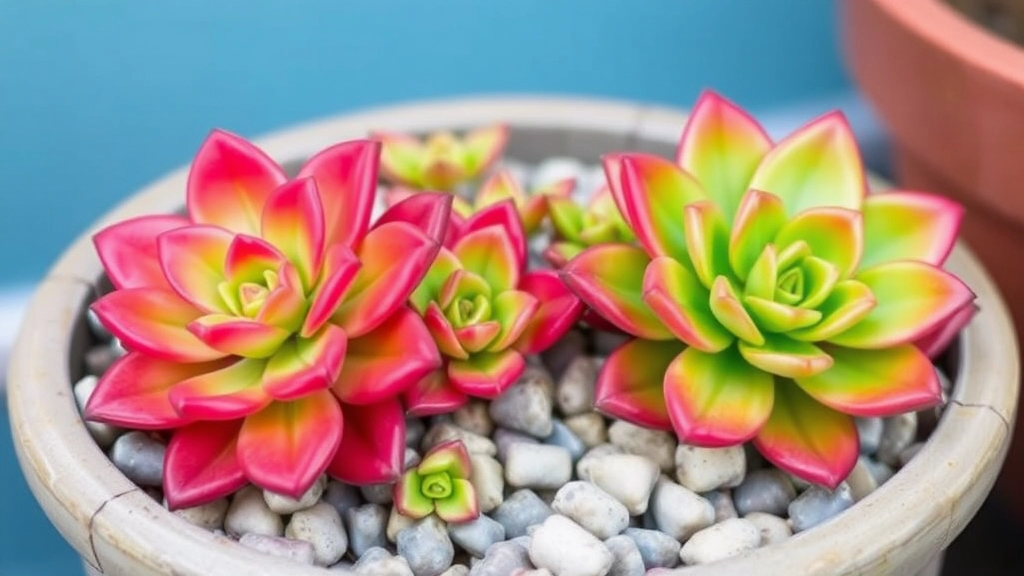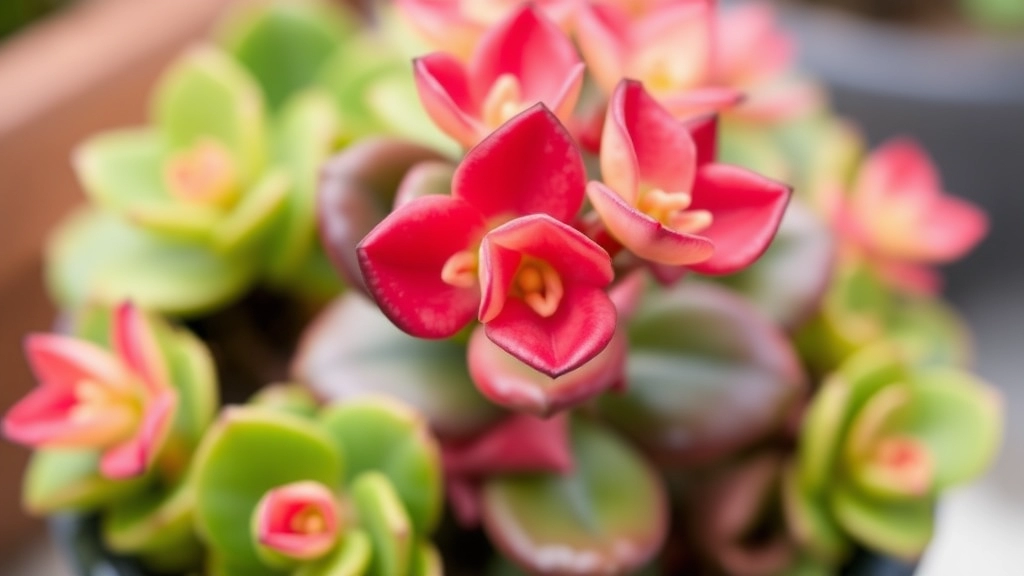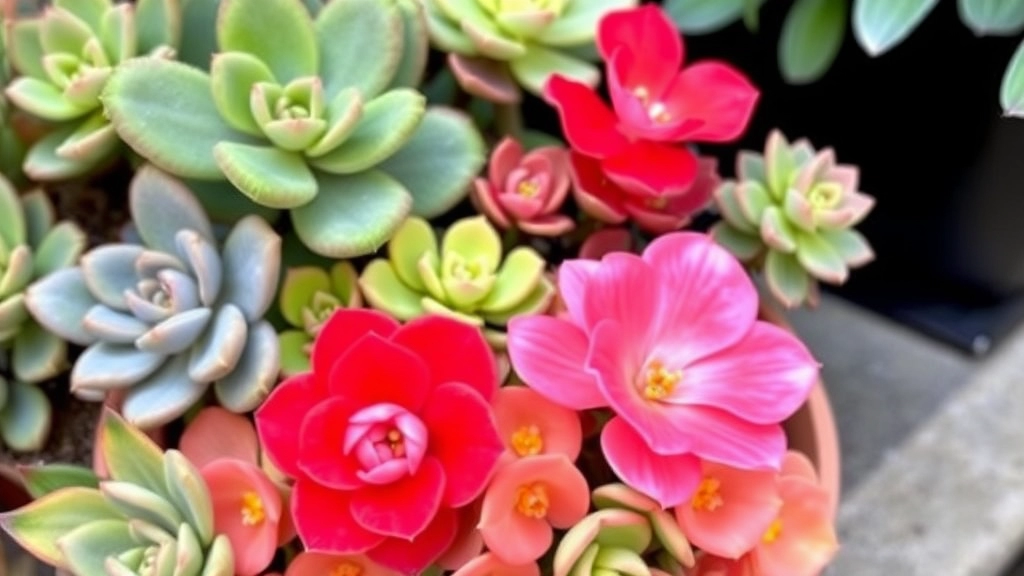Kalanchoe Succulent Varieties
When it comes to Kalanchoe succulent varieties, there’s a lot to explore. Whether you’re a seasoned gardener or just getting started with succulents, these plants offer a unique blend of aesthetic appeal and low-maintenance care. From the vibrant Kalanchoe blossfeldiana to the intriguing Kalanchoe tomentosa, each variety brings something special to your home or garden.
In this guide, I’ll walk you through some of the top Kalanchoe varieties, highlighting their unique features and care needs. You’ll find tips on how to propagate these succulents, the best soil conditions, and how to ensure they thrive in your space. Let’s dive into the world of Kalanchoe and discover which variety is perfect for you.
When considering the best Kalanchoe varieties for your home or garden, you might wonder which ones truly stand out. Kalanchoe plants are not only visually appealing but also incredibly versatile.
### 1. Kalanchoe Blossfeldiana
– **Description**: Known for its vibrant, clustered flowers, this variety blooms in a range of colours, including red, pink, yellow, and white.
– **Ideal Conditions**: Thrives in bright, indirect light and needs well-draining soil.
– **Care Tip**: Water sparingly; allow the soil to dry out between waterings.
For more detailed care instructions, check out the [complete care guide for Kalanchoe Blossfeldiana succulent](https://planthq.org/complete-care-guide-for-kalanchoe-blossfeldiana-succulent/).
### 2. Kalanchoe Tomentosa (Panda Plant)
– **Description**: This succulent features fuzzy, grey-green leaves with brown edges, resembling panda ears.
– **Ideal Conditions**: Prefers bright light and can tolerate some direct sun.
– **Care Tip**: Keep the soil dry; overwatering can lead to root rot.
### 3. Kalanchoe Luciae (Flapjack Plant)
– **Description**: With its large, flat leaves that turn a stunning red in full sun, this variety is a showstopper.
– **Ideal Conditions**: Needs full sun and well-draining soil.
– **Care Tip**: Minimal watering is required; let the soil dry out completely.
### 4. Kalanchoe Pinnata (Mother of Thousands)
– **Description**: Famous for producing tiny plantlets along the edges of its leaves, this variety is quite unique.
– **Ideal Conditions**: Thrives in bright light and can tolerate drought.
– **Care Tip**: Control its growth, as it can become invasive in some regions.
Learn more about its benefits and uses in our [guide on Kalanchoe Pinnata](https://planthq.org/kalanchoe-pinnata-benefits-and-uses-in-tamil-nadu/).
### 5. Kalanchoe Fedtschenkoi (Chandelier Plant)
– **Description**: This variety has distinctive, scalloped leaves that can grow quite large.
– **Ideal Conditions**: Prefers bright, indirect sunlight.
– **Care Tip**: Water when the top inch of soil feels dry.
Unique Features of Popular Kalanchoe Succulents

Have you ever wondered what makes Kalanchoe succulents so special?
These charming plants come with a variety of unique features that can brighten up any home or garden.
1. Diverse Leaf Shapes and Textures
- Kalanchoe leaves can range from smooth and glossy to textured and fuzzy.
- Some varieties, like the Kalanchoe tomentosa (Panda Plant), have adorable, velvety leaves with a hint of red on the edges.
2. Vibrant Flowering
- Many Kalanchoe species bloom stunning clusters of flowers in bright colours.
- The Kalanchoe blossfeldiana is particularly popular for its long-lasting blooms, making it a favourite for indoor décor.
3. Easy to Care For
- These succulents are resilient and thrive in various conditions.
- They can tolerate neglect, making them ideal for busy folks or those new to gardening.
4. Medicinal Properties
- Some Kalanchoe species, like Kalanchoe pinnata, are known for their medicinal uses.
- They have been traditionally used for their healing properties in various cultures.
5. Variety of Sizes
- From petite tabletop varieties to larger garden specimens, Kalanchoe comes in various sizes.
- This versatility allows you to find the perfect fit for your space, whether it’s a small apartment or a sprawling garden.
How to Care for Different Kalanchoe Species
Caring for Kalanchoe plants can seem daunting, especially with the variety of species available. However, understanding their specific needs can make the process straightforward and enjoyable.
General Care Tips
Regardless of the species, there are some universal care tips you should keep in mind:
- Light Requirements: Kalanchoes thrive in bright, indirect sunlight. Place them near a window but avoid harsh afternoon sun, which can scorch their leaves.
- Watering: Overwatering is a common issue. Allow the top inch of soil to dry out before watering again. Generally, watering every two weeks is sufficient.
- Soil: Use a well-draining succulent mix to prevent root rot. A mix of potting soil and sand works well.
- Temperature: Kalanchoes prefer temperatures between 15°C and 25°C (59°F to 77°F). Protect them from frost and extreme heat.
Caring for Specific Species
Now, let’s break it down by popular Kalanchoe species:
- Kalanchoe blossfeldiana:
- Watering: Water less during the blooming season to prolong flowers.
- Fertiliser: Use a balanced fertiliser every month during the growing season.
- Kalanchoe tomentosa (Panda Plant):
- Humidity: This species enjoys slightly higher humidity, so mist occasionally.
- Pruning: Trim off any dead leaves to maintain its bushy appearance.
- Kalanchoe luciae (Paddle Plant):
- Light: Ensure it gets direct sunlight for at least 4 hours a day for vibrant colour.
- Pot Size: Choose a pot that allows for growth; they can become top-heavy.
By tailoring your care routine to the specific needs of each Kalanchoe species, you’ll encourage healthy growth and vibrant blooms. For more detailed care tips, you can refer to our Kalanchoe blossfeldiana family care guide and our Kalanchoe beharensis care tips.
Propagation Tips for Growing New Kalanchoe Plants

After exploring the unique features of various Kalanchoe species, you may find yourself eager to expand your collection. Propagating Kalanchoe plants is a rewarding experience that allows you to create new plants with minimal effort. Here are some straightforward tips to help you get started on your propagation journey.
Types of Propagation
- Leaf Cuttings
- Select a healthy leaf from your Kalanchoe.
- Allow the cutting to dry for a few hours to form a callus.
- Place the leaf on well-draining soil, ensuring it makes contact.
- Water sparingly until roots develop.
- Stem Cuttings
- Cut a healthy stem about 4-6 inches long.
- Remove the lower leaves.
- Let the cutting dry for a day to form a callus.
- Plant in soil and water lightly.
- Offsets
- Some Kalanchoe varieties produce offsets, or “pups.”
- Gently separate the offsets from the parent plant.
- Plant them in their own pots with suitable soil.
Ideal Conditions for Propagation
- Light: Bright, indirect sunlight is crucial for healthy growth.
- Temperature: Kalanchoe thrives in temperatures between 20-25°C (68-77°F).
- Soil: Use a well-draining cactus or succulent mix to prevent rot.
Common Mistakes to Avoid
- Overwatering: Ensure the soil dries out between waterings.
- Insufficient light: Lack of light can stunt growth and lead to leggy plants.
- Neglecting humidity: While Kalanchoe prefers dry conditions, a bit of humidity can help with root development.
Final Thoughts on Propagation
With these simple propagation methods, you can easily grow new Kalanchoe plants to share with friends or enhance your home. It’s a fulfilling process that connects you more deeply with your plants.
Choosing the Right Kalanchoe for Your Space
When considering the addition of Kalanchoe to your home or garden, it’s essential to reflect on your specific environment and lifestyle.
What to Consider:
- Light Requirements:
- Kalanchoe thrives in bright, indirect sunlight.
- If your space has limited natural light, opt for varieties like Kalanchoe blossfeldiana, which can tolerate lower light conditions.
- Space Availability:
- Dwarf varieties, such as Kalanchoe tomentosa, are perfect for small spaces or tabletops.
- Larger varieties, like Kalanchoe luciae, need more room to spread out and showcase their unique leaves.
- Climate Adaptability:
- If you live in a cooler climate, consider Kalanchoe beharensis, which can tolerate slightly lower temperatures.
- For warmer zones, Kalanchoe thyrsiflora flourishes in heat and can be a vibrant addition to your outdoor garden.
- Personal Aesthetic:
- Think about the colours and shapes that resonate with your style.
- Kalanchoe comes in a variety of hues, from bright reds to soft greens, allowing you to choose a plant that complements your decor.
- Care Level:
- If you’re new to gardening, look for low-maintenance varieties like Kalanchoe ‘Pink Butterflies.’
- More experienced gardeners might enjoy the challenge of caring for Kalanchoe delagoensis, which requires specific conditions.
FAQs on Kalanchoe Succulent Varieties
What makes Kalanchoe succulents unique?
Kalanchoe succulents are known for their diverse leaf shapes and textures, vibrant flowering, ease of care, medicinal properties, and variety of sizes. These features make them versatile and attractive for both indoor and outdoor settings.
What are some popular Kalanchoe varieties?
Popular Kalanchoe varieties include the Kalanchoe tomentosa (Panda Plant) known for its velvety leaves, and Kalanchoe blossfeldiana, admired for its long-lasting, bright-colored blooms.
How do I care for Kalanchoe succulents?
Kalanchoe succulents are easy to care for. They thrive in various conditions, tolerate neglect, and require minimal watering. They prefer bright, indirect sunlight and well-draining soil.
Do Kalanchoe plants have medicinal properties?
Yes, some Kalanchoe species like Kalanchoe pinnata are known for their medicinal uses. They have been traditionally used for their healing properties in various cultures.
What sizes do Kalanchoe plants come in?
Kalanchoe plants come in a variety of sizes, from petite tabletop varieties to larger garden specimens. This allows you to choose the perfect size for your space.
FAQs on Propagating Kalanchoe Plants
What are the methods for propagating Kalanchoe plants?
Kalanchoe plants can be propagated through leaf cuttings, stem cuttings, and offsets. Each method involves allowing the cuttings to dry and form a callus before planting them in well-draining soil.
What conditions are ideal for propagating Kalanchoe?
For successful propagation, provide bright, indirect sunlight, maintain temperatures between 20-25°C (68-77°F), and use well-draining cactus or succulent mix soil to prevent rot.
What are common mistakes to avoid when propagating Kalanchoe?
Avoid overwatering, ensure the soil dries out between waterings, provide sufficient light to prevent leggy growth, and maintain a bit of humidity to aid root development.
Why should I propagate Kalanchoe plants?
Propagating Kalanchoe plants is a rewarding experience that allows you to expand your collection, share plants with friends, and connect more deeply with your gardening hobby.
References
-
Kalanchoe Succulent Varieties
-
How to Care for a Kalanchoe Plant
-
Kalanchoe: How to Grow and Care for Kalanchoe Plants
